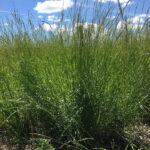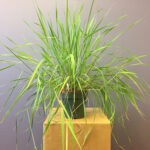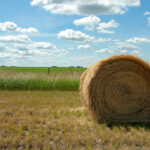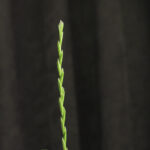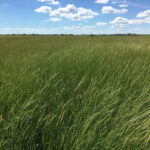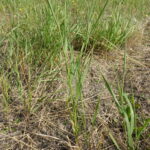Herbe à blé verte
Elymus hoffmannii
General Description
Green wheatgrass is a cross of Agropyron spicatum (bluebunch wheatgrass) and Agropyron repens (quackgrass). NewHy is a synthetic cross made in the United States. AC Saltlander is a natural hybrid that was collected in Europe and further selections were done in the United States and Canada. All following information on green wheatgrass is based on AC Saltlander type green wheatgrass.
Green wheatgrass is an introduced perennial forage grass that demonstrates exceptional salinity tolerance. Its extensive, creeping root system can dewater saline areas and spread out, covering the ground to compete with unwanted, unproductive or unpalatable plants. Green wheatgrass is a tall (75 cm / 30 in) upright plant. Leaves are smooth with no hairs. The leaves are generally 5-13 mm (0.02-0.05 in) wide. Green wheatgrass has tall, spiked seed heads similar to intermediate wheatgrass. In addition, AC Saltlander is productive, palatable, and has good nutritional qualities.
Type
Tame grass.
Origin
Originally developed in Canada and the United States from cross between quackgrass (Elymus repens) and bluebunch wheatgrass (Pseudoroegneria spicata).
Longevity
At least 20 years.
Use
Pasture, hay.
Optimal Time of Use
Spring, summer. Green wheatgrass begins growing early in the spring. Graze green wheatgrass before heading. Hay green wheatgrass as it comes into flower. Vegetative regrowth may be used again. Currently, there is no research confirming the suitability for fall grazing or stockpiled grazing. However, the practice may be possible.
Recovery After Use
Requires a minimum 60-80 days of recovery after use. If green wheatgrass is initially grazed late in the growing season, regrowth is substantially less. Green wheatgrass has low growing points and is moderately tolerant to intensive grazing.
Palatability/Nutritional Value
Green wheatgrass has good palatability and quality. Grazing studies have now proven palatability holds until at least late summer. Green wheatgrass average quality is to be 15-19% crude protein, approximately 50% NDF and 60-67% digestibility.
Annual Precipitation min/max (mm)
Limits have not been established. 300mm per year has been sufficient.
Drought Tolerance
Good tolerance.
Flooding Tolerance
Withstands 2-5 weeks of spring flooding once established.
Winter Hardiness
Good hardiness.
Soil Texture Preference
Adapted to all soil textures.
Erosion Control
High ability to control erosion. Creeping roots bind the soil.
Salinity Tolerance
High tolerance. Salinity tolerance was a primary selection criterion when being developed. AC Saltlander green wheatgrass salinity tolerance equals that of tall wheatgrass.
Acidity Tolerance
Moderate tolerance.
Alkalinity Tolerance
Unknown
Seeds per kg
244,000 seeds/kg (111,000 seeds/lb).
Suggested Mixtures
Green wheatgrass is a strong competitor in a mix, including with alfalfa. It is a stronger competitor than intermediate wheatgrass or crested wheatgrass. A typical mixture in low to moderate salinity is a salt tolerant alfalfa, while in moderate to severe salinity a typical mixture would include slender wheatgrass.
Ease of Establishment
Green wheatgrass seedlings are vigorous and establish easily. It spreads by rhizomes to fill in areas between plants.
Competitiveness
Green wheatgrass is very competitive, even on saline sites. It has the ability to outcompete foxtail barley and downy brome. It spreads by rhizomes significantly less than quackgrass. Its ability to spread into native habitats (upland and riparian) has not been well studied.
Management Considerations
Green wheatgrass was developed for use in saline areas, and is best served being seeded on such sites. Invasiveness may be a concern when planting green wheatgrass adjacent to natural areas or across an entire field.
Saskatchewan Dryland Forage Species Adaptation Tool, USDA Plants Database, AAFC- AC Saltlander green wheatgrass Factsheet, AAFC- AC Saltlander Technical Bulletin
Green wheatgrass is likely best adapted to the drier zones in the southern part of the region, e.g., the Bunchgrass and Interior Douglas-fir zones, and mainly for use on soils with high salinity. Experience with green wheatgrass in BC is limited.
Green wheatgrass is likely best adapted to the drier zones in the region, i.e., the Bunchgrass, Ponderosa Pine and Interior Douglas-fir zones, and mainly for use on soils with high salinity. Experience with green wheatgrass in BC is limited.
Western wheatgrass is found in native grassland communities in the Peace-Liard region, sometimes with slender wheatgrass, western porcupine grass and northern wheatgrass.
